In the realm of nature’s cornucopia, countless intriguing specimens are waiting to be discovered. Today, we embark on a journey to uncover some of the world’s most mysterious fruits. And we invite you to join us in marveling at their existence and pondering the wonders of Mother Nature. Each fruit, with its own unique story, provides an opportunity for us to learn more about the incredible biodiversity that our planet has to offer. By appreciating these fruits and the environments in which they thrive, we can better understand the importance of protecting our planet’s resources for generations to come.
Among the vast array of flora across the globe, certain fruits hold a special place in the hearts of those who dare to explore the unknown. These fruits, with their peculiar origins and characteristics, have captivated the minds of countless curious individuals. From the depths of dense rainforests to the highest reaches of mountain peaks, these fruits can be found in the most unexpected places.
Each of these extraordinary fruits has a story that adds to its mystique. Some are surrounded by legends and folklore, while others have been discovered only recently by intrepid explorers. The tales surrounding these fruits often weave a tapestry of cultural significance, captivating generations with their allure. Many of these fruits have made their way into the culinary world, where they are prized for their rarity and the innovative flavors they bring to the table. These mysterious fruits have inspired chefs to push the boundaries of traditional cuisine, creating new and exciting dishes that celebrate the complexities of nature’s bounty.
In some instances, the fruits’ hidden secrets have led to remarkable breakthroughs in various research fields. Scientists, for example, have been able to unlock some of the fruits’ unique properties and harness them for the greater good. From potential medical applications to sustainable environmental solutions, these fruits continue to reveal surprises with each new discovery. But it’s not only their unknown qualities that make these fruits so fascinating. The fruits’ unusual appearance and growth patterns can be equally captivating in many cases. Some fruits boast intricate designs that testify to the wonders of evolution, while others seem to defy logic in how they grow and mature. The more we learn about these fruits, the more we appreciate our planet’s incredible biodiversity.
Moreover, these fruits often remind us of the importance of preserving our environment and its rich resources. The very existence of these mysterious fruits is threatened by habitat loss, climate change, and other human-induced factors. By protecting the ecosystems that house these fruits, we can ensure that future generations have the opportunity to experience the thrill of uncovering nature’s secrets.
#1 Fruit of the hala aka puhala tree
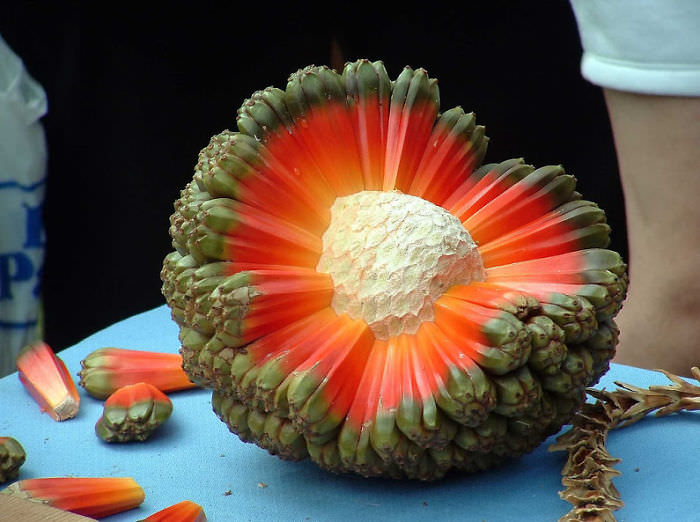
The fruit of the hala, also known as the puhala tree, is a unique fruit that is native to Hawaii. The fruit is known for its large size and spiky exterior, which can make it difficult to handle. The fruit itself is not eaten, but the pulp surrounding the seeds is edible and has a sweet, juicy flavor that is similar to pineapple. The hala tree is found throughout the Pacific Islands and is an important part of many local cultures. The leaves of the hala tree are used to weave baskets, mats, and other items, while the bark is used to make medicine. In addition to its cultural significance, the hala tree and its fruit have a number of practical uses. The seeds can be roasted and eaten, and the wood is used for carving and construction. Overall, the hala fruit is a unique and important part of Hawaiian culture and cuisine.
#2 Horned Melon
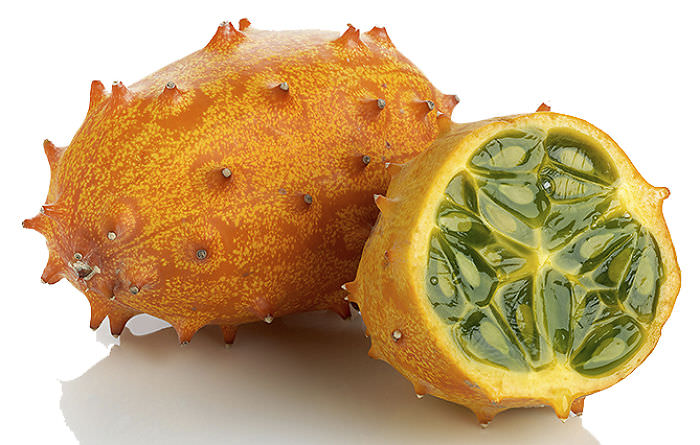
The Horned Melon, also known as Kiwano, is a tropical fruit that is native to Africa. It is a peculiar-looking fruit, with a spiky, bright orange or yellow exterior that is covered in small horns. The inside of the fruit is filled with a gelatinous green pulp that is dotted with edible seeds.
The flavor of the Horned Melon is often described as a combination of banana, cucumber, and lemon, with a slightly tart and refreshing taste. It is often used in salads, smoothies, and other dishes as a unique and exotic ingredient.
The Horned Melon is now grown in many parts of the world, including the United States, Australia, and New Zealand, and is becoming more widely available in supermarkets and specialty food stores. It is also considered to be a good source of vitamins and antioxidants, making it a healthy addition to any diet.
#3 Rambutan
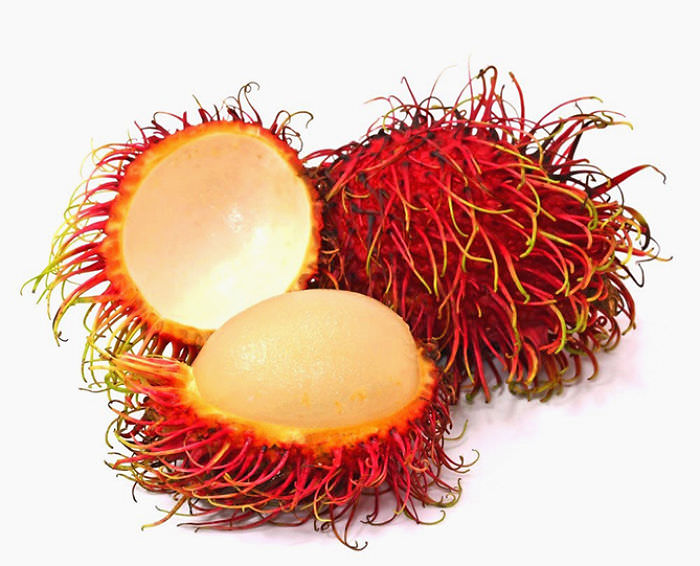
Rambutan is a tropical fruit that is native to Southeast Asia, particularly Malaysia and Indonesia. It is a small fruit, about the size of a golf ball, with a spiky, reddish-brown exterior that is covered in soft, hair-like protrusions.
Once the exterior is removed, the inside of the rambutan fruit reveals a translucent, white flesh that is juicy and sweet, with a flavor similar to that of lychee or grape. The fruit also contains a large seed in the center that is not edible.
Rambutan is typically eaten fresh, either on its own or as a dessert topping, and is also used in fruit salads, smoothies, and other dishes. It is rich in vitamin C, iron, and other nutrients, making it a healthy addition to any diet.
Today, rambutan is grown in many tropical regions of the world, including South America, Africa, and Australia, and is enjoyed by people all over the globe for its unique taste and texture.
#4 Mangosteen
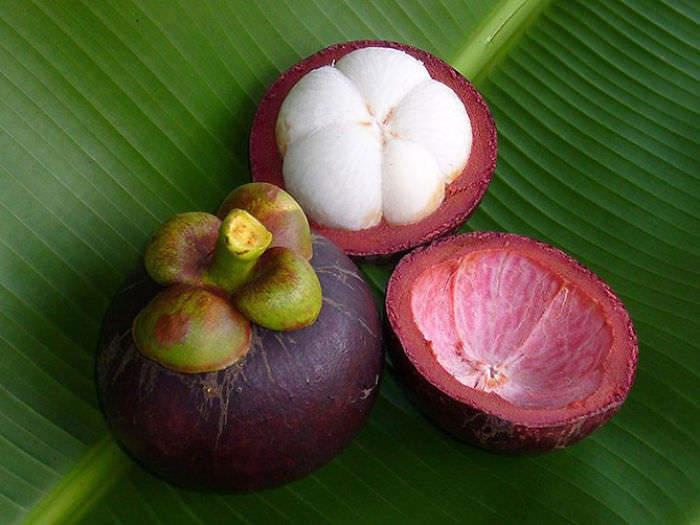
Mangosteen is a tropical fruit that is native to Southeast Asia, particularly Thailand, Indonesia, and Malaysia. The fruit is about the size of a small apple, with a dark purple exterior that is hard and inedible. Inside the fruit, there are several segments of juicy, white flesh that are sweet and tangy, with a flavor that is often described as a mix of strawberry and peach.
Mangosteen is typically eaten fresh and can be found in many tropical markets throughout the world. It is also used in desserts, jams, and sauces, and is believed to have a number of health benefits due to its high levels of antioxidants.
While mangosteen is grown in many parts of the world, it is still considered a delicacy in many places, due to its short shelf life and the fact that it is difficult to transport long distances without damage. However, for those lucky enough to try it, mangosteen is considered one of the most delicious fruits in the world.
#5 Ackee
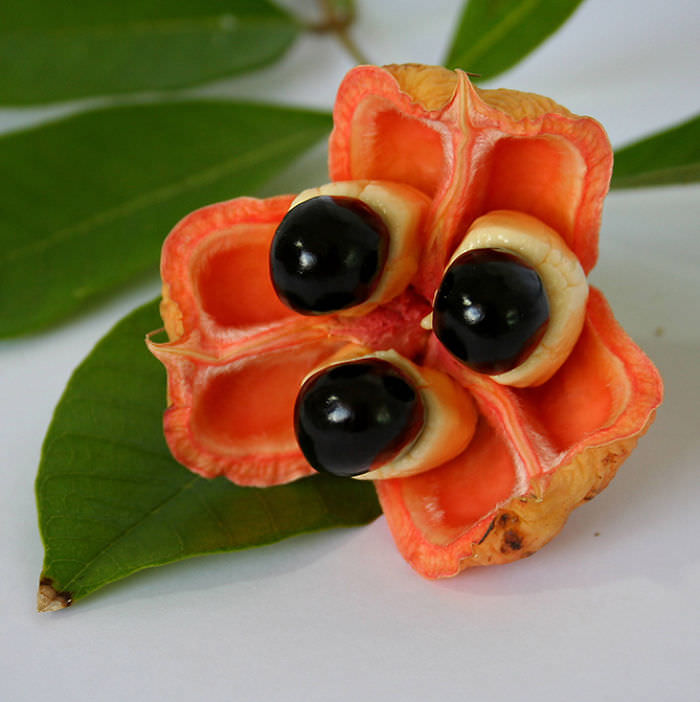
Ackee is a fruit that is native to West Africa and is now widely grown in Jamaica, where it is the national fruit. The fruit is pear-shaped and has a bright red or yellow exterior. However, the most important part of the fruit is its creamy, white-colored flesh that surrounds three large, black seeds.
When cooked, ackee flesh has a texture similar to scrambled eggs and a mild, slightly nutty flavor. It is often used in Jamaican cuisine, where it is typically paired with saltfish and served as a breakfast dish.
Despite its culinary popularity, ackee is actually toxic if consumed improperly. The fruit must be fully ripe and cooked thoroughly before eating, and the red outer layer and seeds should be discarded, as they contain the toxin hypoglycin A. When prepared correctly, however, ackee is a unique and delicious fruit that is an important part of Jamaican culture and cuisine.
#6 Akebi
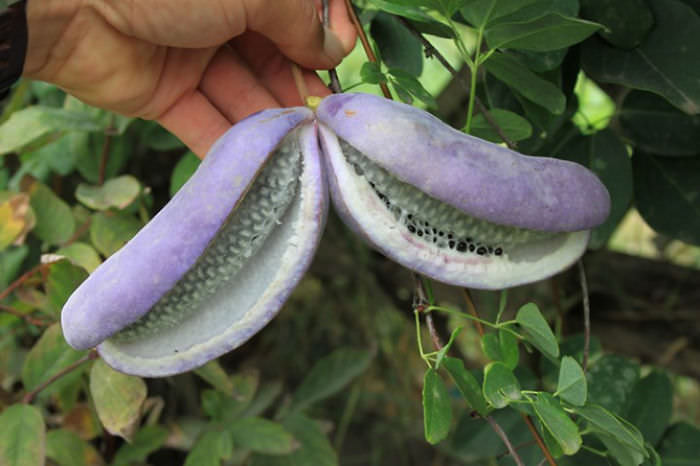
Akebi is a fruit that is native to Japan and is also found in other parts of Asia, including China and Korea. The fruit has a unique, elongated shape and a purplish-brown, leathery exterior that is not edible. Inside the fruit, there is a soft, white flesh that has a slightly sweet flavor and a jelly-like texture.
Akebi fruit is typically eaten fresh and can also be used in desserts, jams, and other dishes. In Japan, the fruit is often paired with sake or used as a flavoring in alcoholic beverages. The fruit is also rich in nutrients, including vitamins A and C, and has been used in traditional medicine to treat a variety of ailments.
While akebi is not widely known outside of Asia, it is a beloved fruit in many parts of the continent and is highly prized for its unique taste and texture.
#7 Pitaya
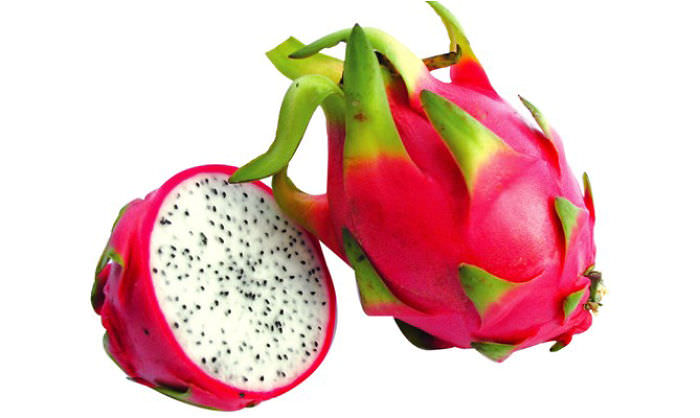
Pitaya, also known as dragon fruit, is a tropical fruit that is native to Mexico and Central America but is now widely grown in Southeast Asia and other parts of the world. The fruit has a striking appearance, with a bright pink or yellow exterior that is covered in green, leaf-like scales.
Inside the fruit, there is a white or pink flesh that is studded with tiny black seeds. The flesh has a mild, slightly sweet flavor that is often compared to that of kiwi or pear. The fruit is typically eaten fresh and is also used in smoothies, cocktails, and other dishes.
Pitaya is known for its high levels of antioxidants, vitamins, and fiber, and is believed to have a number of health benefits. It is also low in calories and sugar, making it a popular choice for those looking to maintain a healthy diet.
#8 Jackfruit
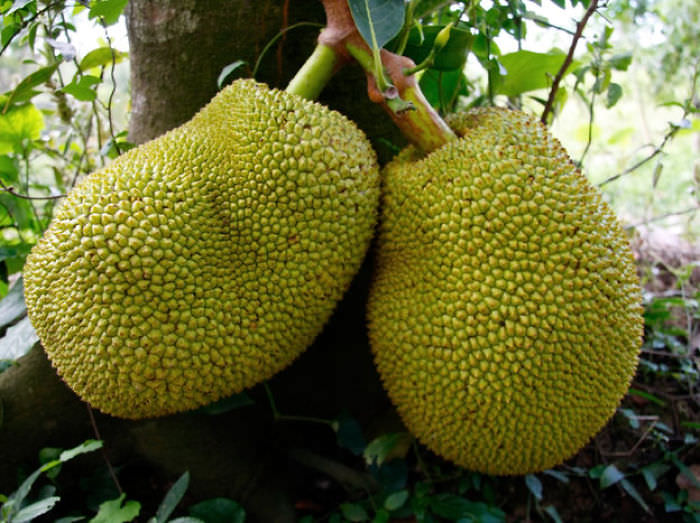
Jackfruit is a tropical fruit that is native to South and Southeast Asia but is now grown in many other parts of the world, including the Caribbean, Africa, and South America. The fruit is one of the largest tree-borne fruits in the world and can weigh up to 80 pounds.
The fruit has a thick, greenish-yellow exterior that is covered in small bumps and spikes. Inside, there are many small, yellow bulbs that are edible and have a sweet, fruity flavor. The bulbs are often used as a meat substitute in vegetarian and vegan dishes, due to their texture and ability to absorb flavors.
Jackfruit is also rich in nutrients, including vitamin C, fiber, and antioxidants, and is believed to have a number of health benefits. It is typically eaten fresh or used in a variety of dishes, including curries, stews, and desserts.
#9 Salak
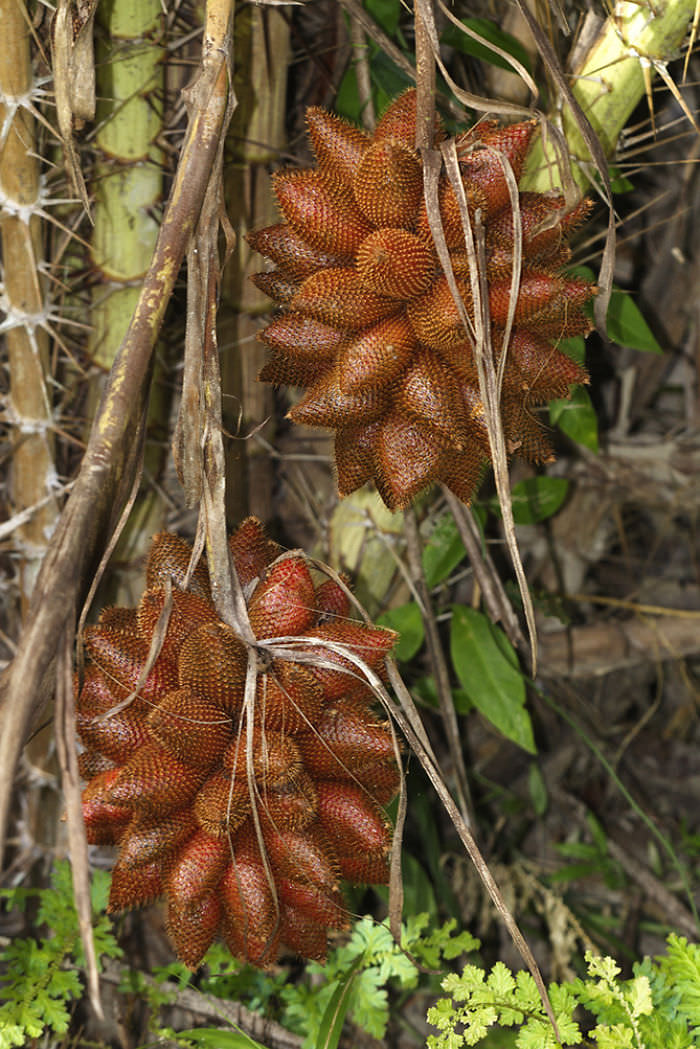
Salak, also known as snake fruit, is a tropical fruit that is native to Indonesia, Malaysia, and Brunei, but is now grown in other parts of Southeast Asia. The fruit gets its name from its scaly, brownish-red exterior, which resembles snake skin.
Inside the fruit, there are 2-3 segments of white, juicy flesh that have a sweet and slightly acidic flavor. The texture of the fruit is similar to that of an apple, but with a rougher, drier consistency. The fruit is typically eaten fresh, but can also be used in desserts and jams.
Salak is rich in nutrients, including vitamins C and A, fiber, and potassium, and is believed to have a number of health benefits. It is also low in calories and sugar, making it a popular choice for those looking to maintain a healthy diet.
#10 Carambola
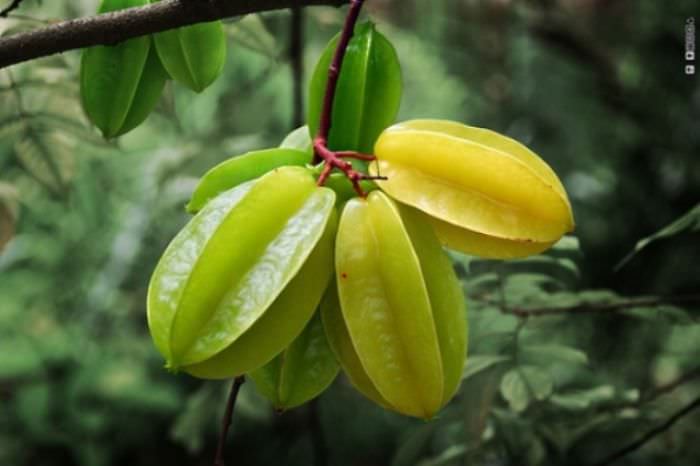
Carambola, also known as starfruit, is a tropical fruit that is native to Southeast Asia and is now grown in many other parts of the world, including South America, the Caribbean, and parts of Africa. The fruit gets its name from its unique shape, which resembles a star when sliced.
The exterior of the fruit is yellow-green and covered in small, bumpy ridges. Inside, there is a juicy, translucent flesh that has a sweet and slightly tart flavor, with notes of citrus and apple. The fruit is typically eaten fresh and is also used in salads, smoothies, and other dishes.
Carambola is low in calories and high in nutrients, including vitamin C, fiber, and antioxidants, and is believed to have a number of health benefits. However, it should be noted that the fruit contains a high level of oxalic acid, which can be harmful to those with kidney problems.
#11 Buddha’s Hand
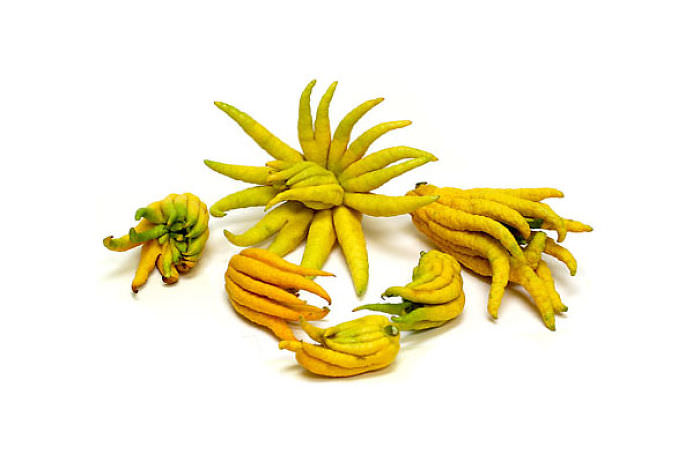
Buddha's Hand, also known as fingered citron, is a unique fruit that is native to Asia, particularly China and India. The fruit has a striking appearance, with long, finger-like protrusions that give it the appearance of a hand.
Unlike many other fruits, Buddha's Hand has little to no flesh or juice, and is primarily valued for its aromatic rind. The rind is used in a variety of ways, including as a flavoring for candy, desserts, and liqueurs. The fruit is also sometimes used for ornamental purposes.
While not as widely known or consumed as some other fruits, Buddha's Hand is a unique and beloved ingredient in many parts of Asia and is becoming increasingly popular in other parts of the world for its distinct flavor and fragrance.
#12 Purple Sweet Potato
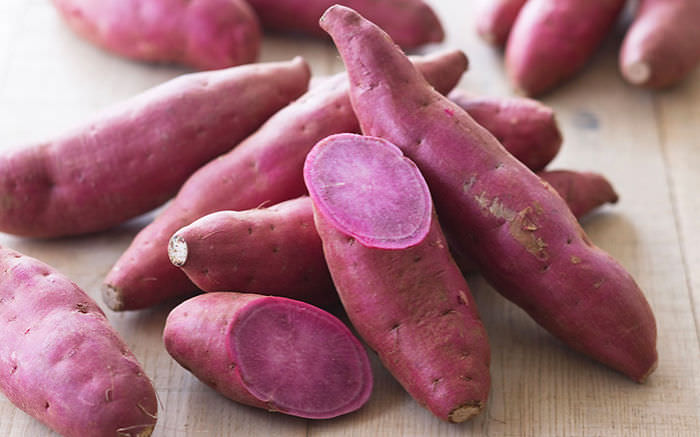
Purple sweet potato, also known as purple yam, is a root vegetable that is native to Asia but is now grown in many other parts of the world, including the Americas and Africa. The potato has a bright purple color, which comes from its high levels of anthocyanin, a type of antioxidant.
The flesh of the potato is also purple, and has a slightly sweet flavor that is similar to regular sweet potatoes. It can be cooked in a variety of ways, including roasting, boiling, and frying, and is a popular ingredient in many dishes, both sweet and savory.
Purple sweet potato is known for its high levels of antioxidants, fiber, and other nutrients, and is believed to have a number of health benefits. It is also a popular ingredient in many gluten-free and vegan recipes, due to its natural sweetness and versatility.
#13 Black Sapote (Chocolate Pudding Fruit)
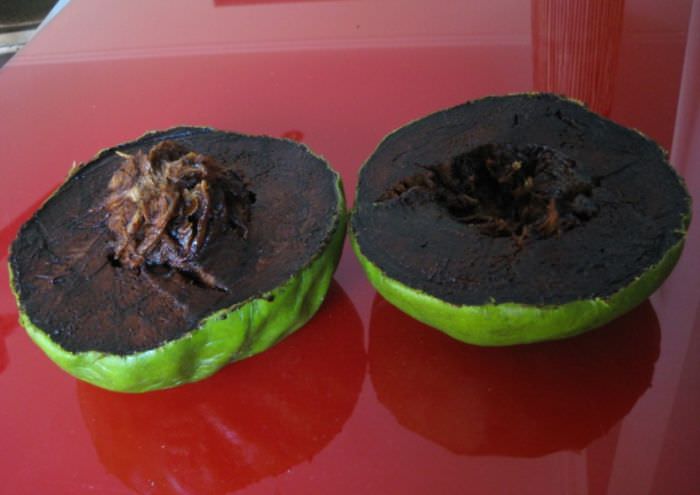
Black Sapote, also known as Chocolate Pudding Fruit, is a tropical fruit that is native to Mexico and Central America. The fruit is about the size of a large apple and has a greenish-black exterior that becomes softer and darker as it ripens.
Inside the fruit, there is a soft, creamy flesh that is similar in texture and appearance to chocolate pudding. The flesh has a mild, sweet flavor that is often compared to that of chocolate or caramel.
Black Sapote is typically eaten fresh and can also be used in desserts, smoothies, and other dishes. It is low in calories and fat, making it a healthy alternative to traditional chocolate desserts.
While Black Sapote is not as well-known as some other tropical fruits, it is beloved in many parts of Mexico and Central America for its unique flavor and texture. It is also becoming increasingly popular in other parts of the world as a healthy and delicious alternative to traditional chocolate desserts.
#14 Durian
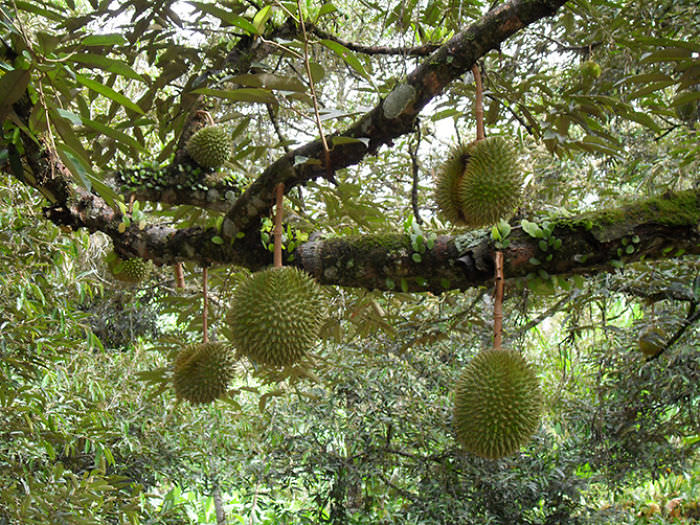
Durian is a tropical fruit that is native to Southeast Asia and is particularly popular in Indonesia, Malaysia, and Thailand. The fruit is known for its strong, pungent smell, which has been described as similar to rotten onions or sweaty socks.
The exterior of the fruit is covered in a thick, spiky husk that must be carefully removed to access the flesh inside. The flesh is creamy and has a unique flavor that is often described as a mix of sweet, savory, and slightly bitter. While some people find the smell and taste of durian unpleasant, others consider it to be a delicacy.
Durian is often used in desserts, candies, and other dishes, and is also known for its nutritional benefits. The fruit is rich in vitamins, minerals, and antioxidants, and is believed to have a number of health benefits, including improving digestion and boosting energy.
#15 Jaboticaba
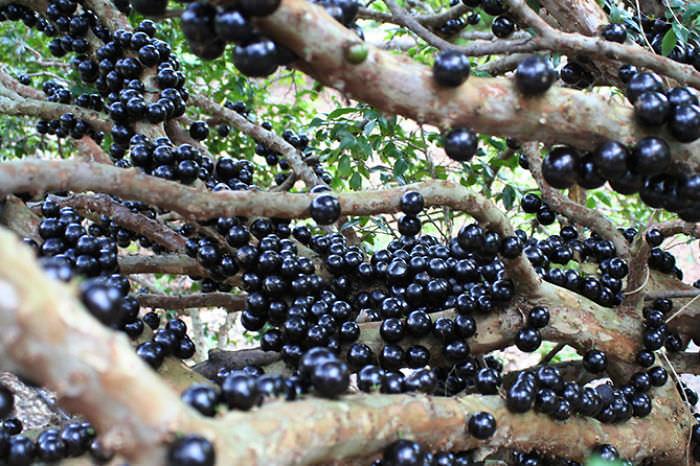
Jaboticaba is a tropical fruit that is native to Brazil and is now grown in other parts of South America, as well as in Florida and California. The fruit is about the size of a grape and has a dark purple, almost black, exterior that is covered in a waxy coating.
Inside the fruit, there is a white or pinkish flesh that is juicy and has a sweet, grape-like flavor. The fruit is typically eaten fresh, and can also be used in jams, jellies, and other desserts.
Jaboticaba is known for its high levels of antioxidants, fiber, and other nutrients, and is believed to have a number of health benefits. It is also a popular ingredient in Brazilian cuisine, and is often paired with meat dishes, as well as used to make wine.
#16 Lichi
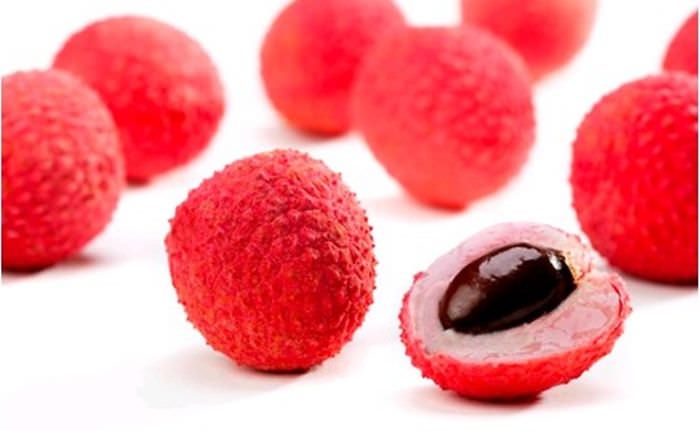
Lychee, also spelled Litchi, is a tropical fruit that is native to Southeast Asia and is now grown in many other parts of the world, including the United States, Australia, and South Africa. The fruit is about the size of a golf ball and has a rough, reddish-pink exterior that is covered in small bumps.
Inside the fruit, there is a white, translucent flesh that is juicy and has a sweet, floral flavor. The fruit is typically eaten fresh, and can also be used in cocktails, desserts, and other dishes.
Lychee is low in calories and high in vitamins, minerals, and antioxidants, and is believed to have a number of health benefits. It is also a popular ingredient in traditional Chinese medicine, and is used to treat a variety of ailments.
#17 Achiote
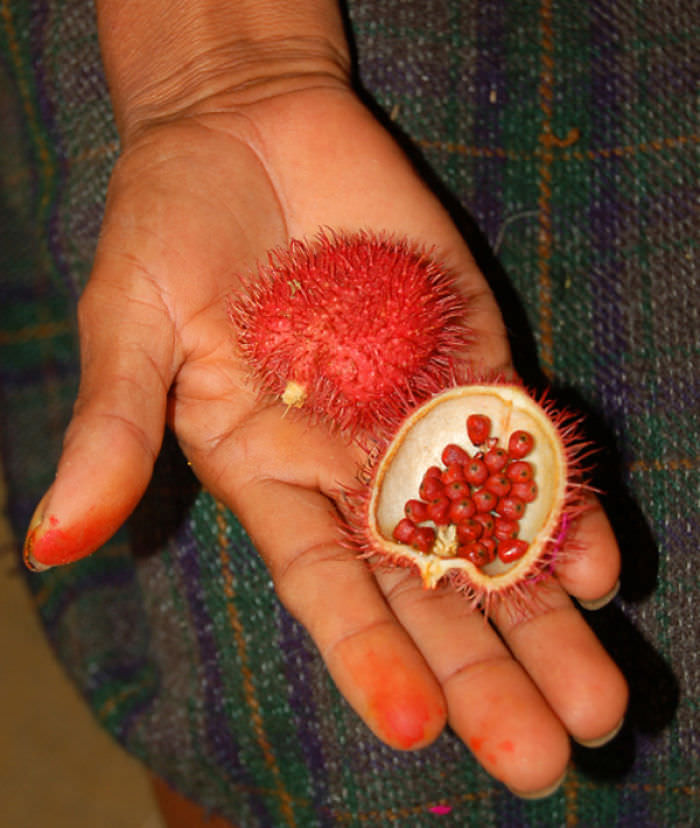
Achiote, also known as annatto, is a spice that is derived from the seeds of the achiote tree, which is native to tropical regions of the Americas. The spice has a bright orange color and is often used as a natural food coloring agent in Latin American and Caribbean cuisine.
In addition to its use as a coloring agent, achiote is also used as a seasoning in many dishes, particularly in Mexican and Central American cuisine. It has a slightly sweet, nutty flavor, and is often used to flavor meats, fish, and rice dishes.
Achiote is also believed to have a number of health benefits, including anti-inflammatory properties and the ability to promote healthy digestion.
#18 Langsat
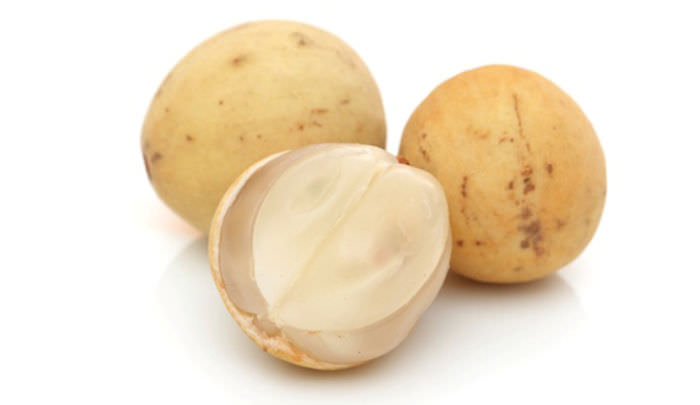
Langsat is a tropical fruit that is native to Southeast Asia, particularly Malaysia, Thailand, and Indonesia. The fruit is small and round, about the size of a golf ball, and has a thin, leathery skin that is yellow or light brown in color.
Inside the fruit, there are several segments of juicy, translucent flesh that have a sweet, tangy flavor. The fruit is typically eaten fresh and is also used in desserts, jams, and other dishes.
Langsat is rich in vitamins, minerals, and antioxidants, and is believed to have a number of health benefits. It is also a popular ingredient in traditional medicine, and is used to treat a variety of ailments.
#19 Aguaje
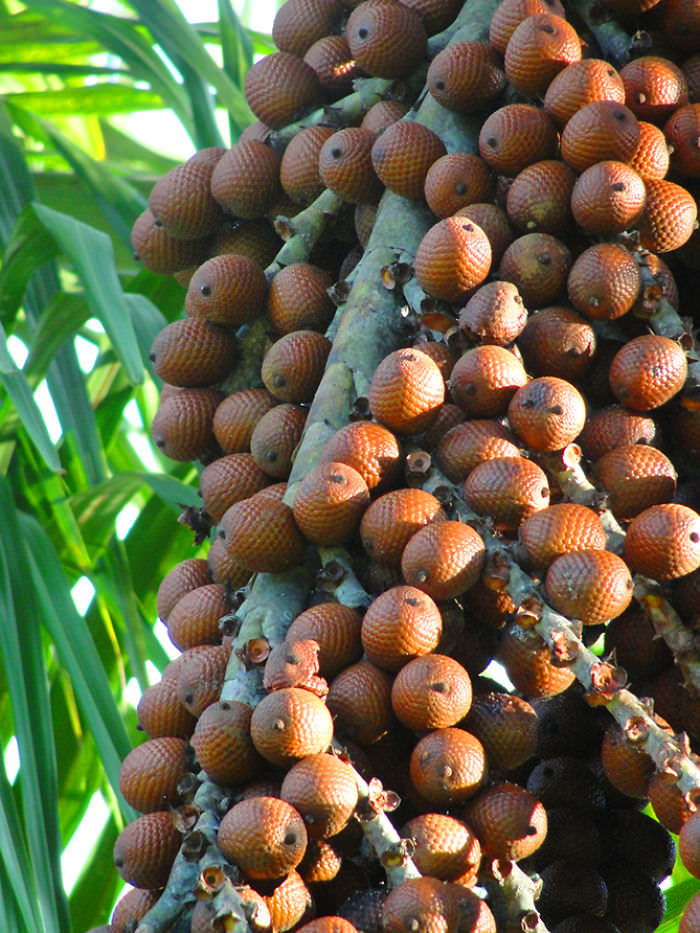
Aguaje, also known as Mauritia flexuosa, is a fruit that is native to the Amazon basin in South America. The fruit is elongated and has a bright, reddish-orange exterior that is covered in small, scaly bumps.
Inside the fruit, there is a yellow or orange flesh that is soft and has a sweet, fruity flavor. Aguaje is often used in traditional Amazonian cuisine, and is used to make juices, jams, and other dishes.
Aguaje is also believed to have a number of health benefits, including its high levels of vitamins A and C, antioxidants, and essential fatty acids. The fruit is also believed to have anti-inflammatory properties and to promote healthy skin and hair.
#20 Cupuaçu
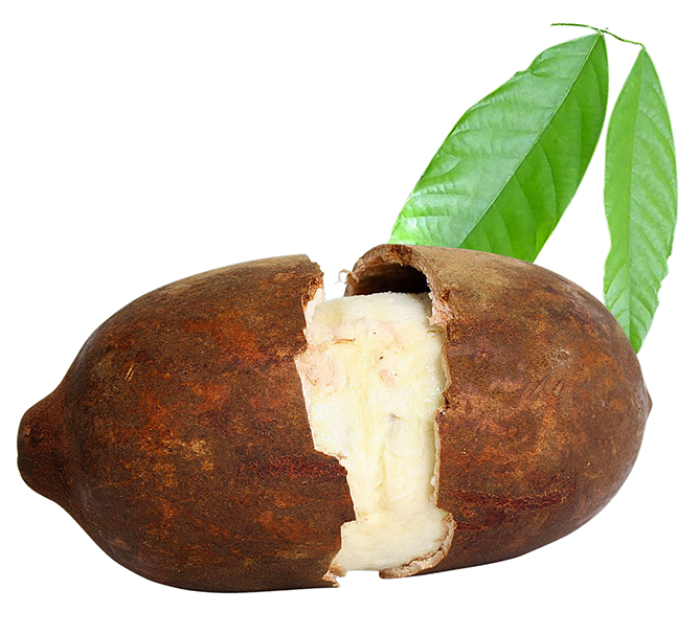
Cupuaçu is a tropical fruit that is native to the Amazon rainforest in South America, particularly Brazil. The fruit is about the size of a large grapefruit and has a thick, woody exterior that is covered in small, spiky bumps.
Inside the fruit, there is a creamy, white pulp that has a sweet, tangy flavor. The fruit is often used in traditional Amazonian cuisine, and is used to make juices, desserts, and other dishes.
Cupuaçu is also believed to have a number of health benefits, including its high levels of vitamins, minerals, and antioxidants. The fruit is also rich in essential fatty acids, which are believed to help promote healthy skin and hair.
#21 Markut Lime
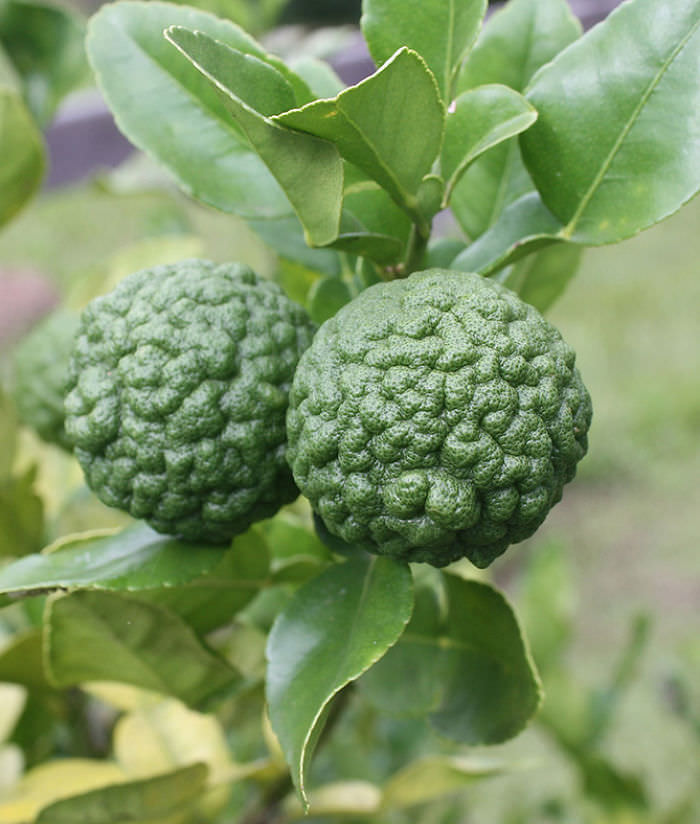
Makrut lime, also known as kaffir lime, is a citrus fruit that is native to Southeast Asia, particularly Thailand and Indonesia. The fruit is small and round, and has a bumpy, green exterior.
Inside the fruit, there is a sour and acidic pulp that is not typically eaten on its own. However, the leaves and zest of the fruit are often used in Thai and Indonesian cuisine to add flavor to curries, soups, and other dishes.
Makrut lime is also believed to have a number of health benefits, including its high levels of antioxidants and vitamin C. The fruit is also believed to have anti-inflammatory properties and to promote healthy digestion.
#22 Cherimoya aka Ice Cream Fruit
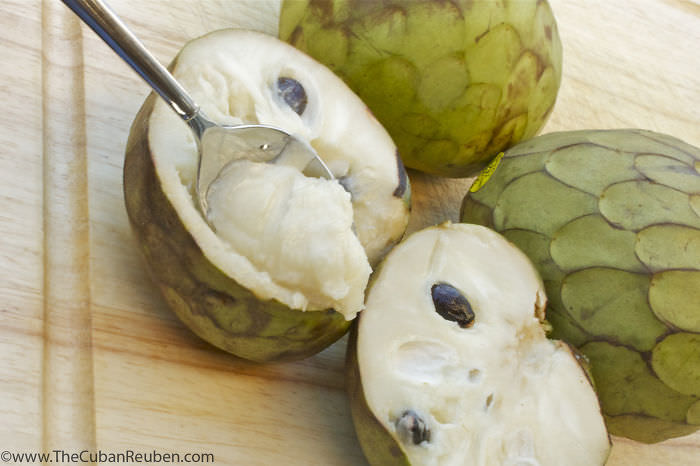
Cherimoya, also known as Ice Cream Fruit, is a tropical fruit that is native to the Andes mountains in South America, but is now grown in many other parts of the world, including California, Spain, and Israel. The fruit is about the size of a large apple and has a green, scaly exterior.
Inside the fruit, there is a soft, white flesh that has a creamy texture and a sweet, tropical flavor that has been compared to that of pineapple, banana, and strawberry. The fruit is often eaten fresh and is also used in desserts, smoothies, and other dishes.
Cherimoya is low in calories and high in vitamins, minerals, and antioxidants, and is believed to have a number of health benefits. It is also a popular ingredient in traditional medicine, and is used to treat a variety of ailments.
#23 Pare/Peria (momordica charantina)
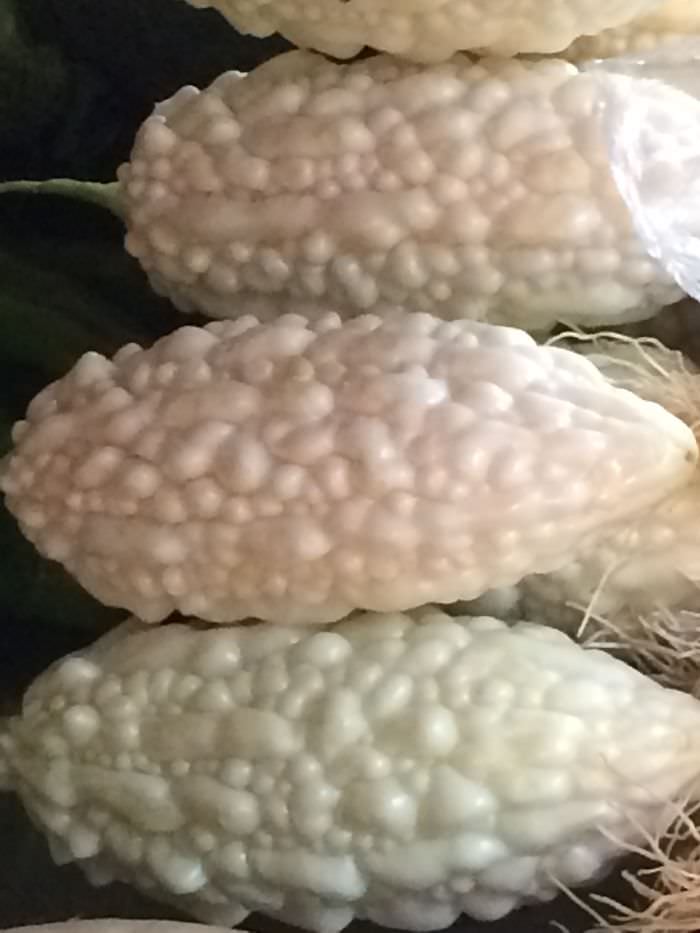
Peria gajih, also known as White Bitter Melon or White Pare, is a variety of bitter melon that is commonly found in Southeast Asia, particularly in Indonesia and Malaysia, as well as in India and Africa.
The fruit is elongated and has a smooth, white exterior, unlike the green, bumpy exterior of the traditional bitter melon. However, the flesh inside is still very bitter in taste, and the fruit is often used in traditional medicine and cuisine, particularly in stir-fries, soups, and curries.
Peria gajih is believed to have a number of health benefits, including its high levels of vitamins, minerals, and antioxidants. It is also low in calories and carbohydrates, making it a healthy addition to many dishes.
#24 Custard Apple
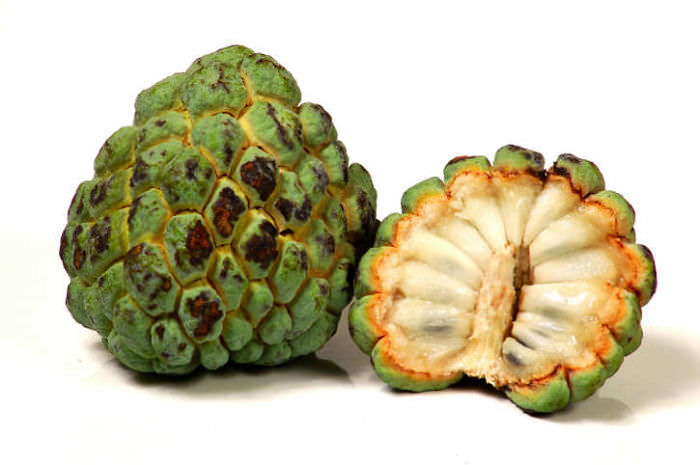
Custard apple is a tropical fruit that is native to Central and South America, but is now grown in many parts of the world, including Southeast Asia, Africa, and the Caribbean. The fruit is about the size of an apple and has a green or brownish exterior that is covered in small, scaly bumps.
Inside the fruit, there is a soft, creamy flesh that has a sweet, fragrant flavor reminiscent of vanilla custard, hence the name "custard apple". The flesh is dotted with small, black seeds that are not typically eaten.
Custard apple is often eaten fresh and is also used in desserts, smoothies, and other dishes. It is low in calories and high in fiber, vitamins, and minerals, making it a healthy addition to any diet.
#25 Hawaiin Papaya
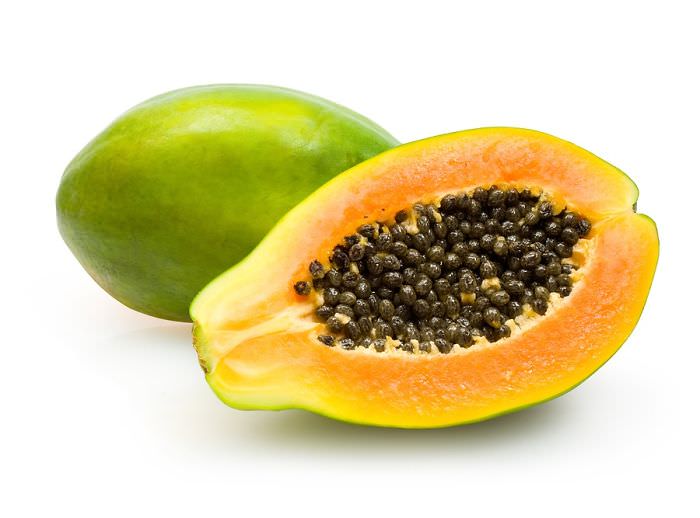
Hawaiian papaya, also known as Rainbow papaya, is a type of tropical fruit that is primarily grown in Hawaii. The fruit is small to medium-sized, and has a yellow-green or yellow-orange exterior, depending on its ripeness.
Inside the fruit, there is a juicy, sweet, and slightly musky flesh that is typically eaten fresh. Hawaiian papaya is also used in many culinary dishes, particularly in smoothies, salads, and salsas.
Hawaiian papaya is low in calories and high in fiber, vitamins, and minerals, particularly vitamin C and vitamin A. It is believed to have a number of health benefits, including improving digestion, boosting immunity, and promoting healthy skin. However, Hawaiian papaya has been genetically modified to resist a virus that threatened papaya crops in the 1990s, which may be a concern for some consumers.
#26 Sapota (Chikoo)
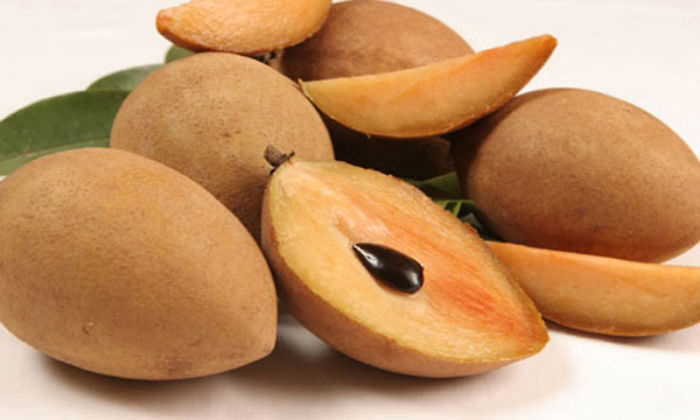
Sapota, also known as chikoo, is a tropical fruit that is native to Mexico, but is now grown in many parts of the world, including Pakistan, Southeast Asia, and the Caribbean. The fruit is about the size of a small apple and has a rough, brown exterior that is somewhat leathery in texture.
Inside the fruit, there is a soft, juicy flesh that is brown in color and has a sweet, caramel-like flavor. The flesh is dotted with small, black seeds that are typically removed before eating.
Sapota is often eaten fresh and is also used in desserts, smoothies, and other dishes. It is high in fiber, vitamins, and minerals, particularly vitamin C, vitamin A, and potassium, making it a healthy addition to any diet.
#27 Physalis
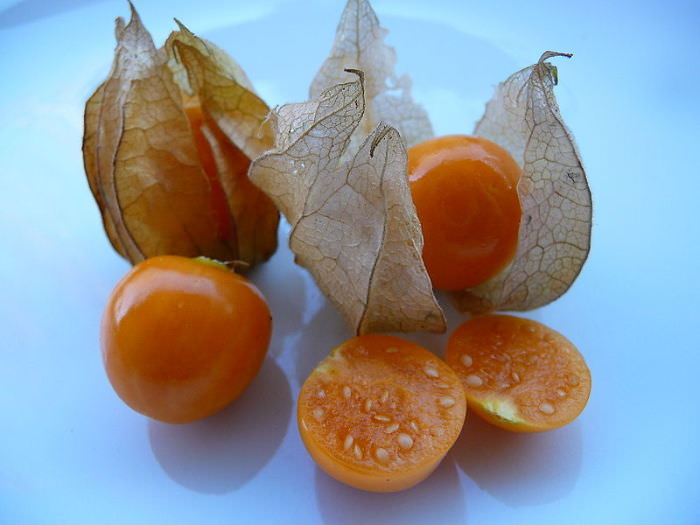
Physalis is a genus of plants that includes a variety of small fruits that are native to the Americas. The most commonly known Physalis fruit is called the Cape gooseberry or goldenberry, and is widely cultivated and consumed around the world.
The fruit is about the size of a cherry tomato, and has a smooth, papery husk that surrounds the bright orange, juicy flesh. The taste of the fruit is tart, and it is commonly used in jams, desserts, salads, and as a garnish in various dishes.
Physalis fruits are rich in vitamins and minerals, particularly vitamin C, and are also high in antioxidants. They are believed to have a number of health benefits, including boosting the immune system, supporting healthy digestion, and promoting healthy skin and eyes.
#28 Kumquat

Kumquat is a small, citrus fruit that is native to China but is now grown in many parts of the world, including the United States, Europe, and Southeast Asia. The fruit is about the size of a grape, and has a bright orange exterior that is edible.
Unlike other citrus fruits, kumquat can be eaten whole, including the skin, which has a sweet taste that is balanced by the sour flesh. The flesh is juicy and contains small seeds that are typically swallowed.
Kumquat is often eaten fresh as a snack, but is also used in desserts, jams, and other dishes. It is rich in vitamins, minerals, and antioxidants, particularly vitamin C, and is believed to have a number of health benefits, including improving digestion and boosting the immune system.
#29 Watermelon Radish
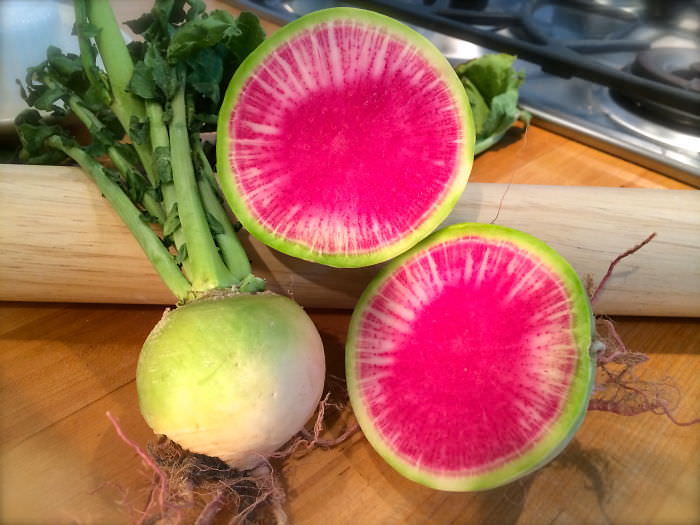
Watermelon radish is a type of heirloom radish that is named for its pink interior that resembles the flesh of a watermelon. The radish has a green and white exterior, but when sliced open, it reveals a vibrant pink or red interior that can range in color from pale pink to deep red.
Watermelon radish has a mild, slightly sweet flavor and a crispy texture, making it a popular ingredient in salads, sandwiches, and other dishes. The radish is rich in vitamins, minerals, and antioxidants, particularly vitamin C and potassium, making it a healthy addition to any diet.
Watermelon radish is also believed to have a number of health benefits, including promoting healthy digestion, supporting a healthy immune system, and reducing inflammation.
#30 Kepel (Stelechocarpus Burahol)
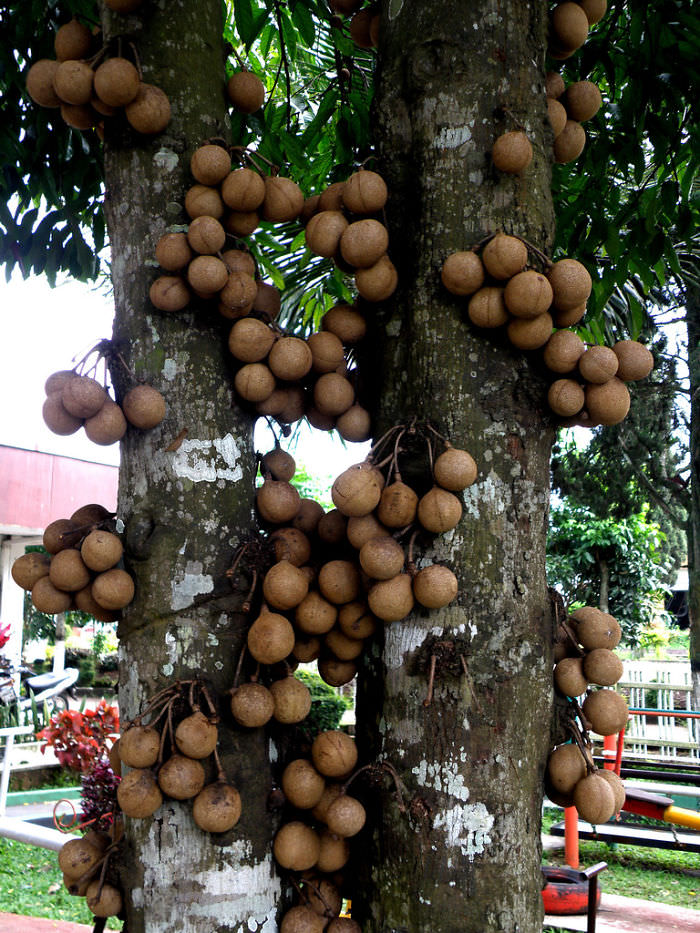
Kepel, also known as Stelechocarpus burahol, is a tropical fruit that is native to Southeast Asia, particularly Indonesia. The fruit is about the size of a small apple and has a smooth, greenish-yellow exterior that is slightly fragrant.
Inside the fruit, there is a white, juicy flesh that has a sweet, floral flavor that is often compared to the taste of a combination of pineapple, mango, and banana. The fruit is often eaten fresh and is also used in desserts, jams, and other dishes.
Kepel is believed to have a number of health benefits, including its high levels of vitamins, minerals, and antioxidants. The fruit is also used in traditional medicine to treat a variety of ailments, including fever, headaches, and digestive issues.
#31 Gac

Gac, also known as Momordica cochinchinensis, is a tropical fruit that is native to Southeast Asia, particularly Vietnam and Thailand. The fruit is about the size of a small melon and has a spiky, bright orange exterior that is typically used for decorative purposes.
Inside the fruit, there is a soft, pulpy flesh that is also bright orange in color. The flesh has a mild, slightly sweet taste and is often used in traditional dishes, particularly in Vietnam and Thailand. The seeds of the fruit are also edible and are rich in lutein and zeaxanthin, two powerful antioxidants that are believed to promote healthy eyesight.
Gac is believed to have a number of health benefits, particularly due to its high levels of antioxidants. The fruit is used in traditional medicine to treat a variety of ailments, including skin conditions, inflammation, and digestive issues.
#32 Miracle Fruit

Miracle fruit, also known as Synsepalum dulcificum, is a tropical fruit that is native to West Africa. The fruit is about the size of a grape and has a red exterior that is similar in appearance to a cranberry.
The fruit contains a protein called miraculin, which has the unique ability to temporarily change the taste perception of sour and bitter flavors to sweet. This effect can last for up to two hours after consuming the fruit, making it a popular ingredient in foods and drinks that are traditionally sour or bitter.
Miracle fruit is low in calories and high in antioxidants and is believed to have a number of health benefits, including regulating blood sugar levels, promoting healthy digestion, and supporting a healthy immune system.
#33 Monstera Deliciosa
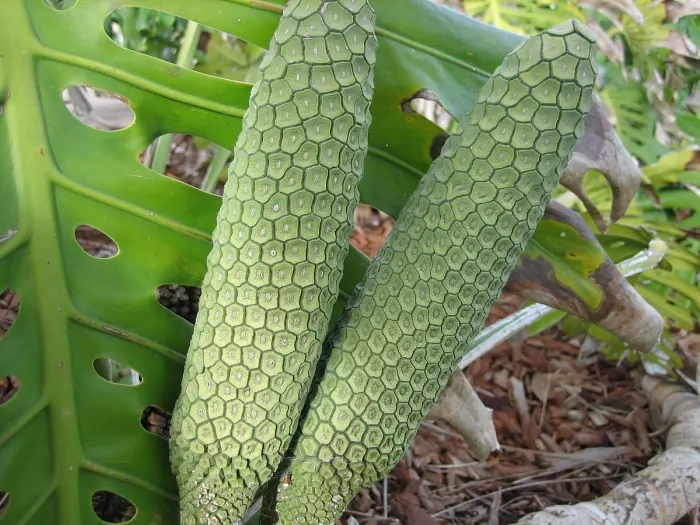
Also known as the Swiss cheese plant or Mexican breadfruit. The fruit of the Monstera deliciosa is not commonly consumed, but is edible when ripe. The fruit has a texture and taste similar to pineapple or jackfruit, and can be eaten raw or used in desserts and drinks. However, the fruit should be consumed only when fully ripe, as the unripe fruit contains a toxin that can cause throat irritation.
#34 Aguaje Fruit
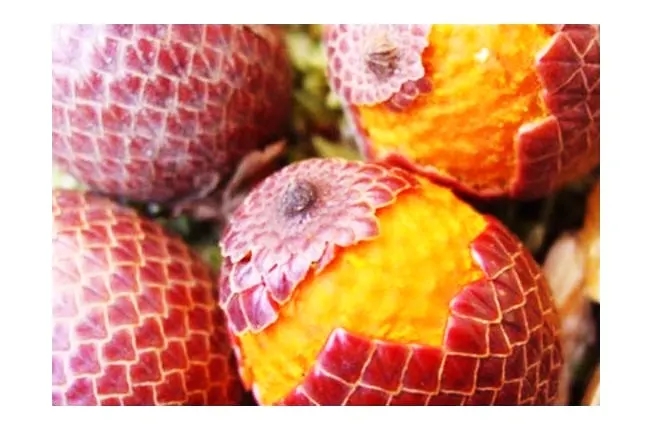
Aguaje fruit, also known as the Mauritia flexuosa, is a tropical fruit that is native to the Amazon rainforest in South America. The fruit is about the size of a small football and has a bright, reddish-orange exterior that is covered in small scales.
Inside the fruit, there is a yellow-orange flesh that has a sweet, slightly tangy taste, similar to that of a carrot or sweet potato. Aguaje fruit is rich in vitamins A, C, and E, as well as antioxidants and essential fatty acids, making it a valuable addition to any diet.
Aguaje fruit is commonly used in traditional medicine in South America, particularly among indigenous communities, for its potential health benefits, which include promoting healthy skin, hair, and nails, supporting a healthy immune system, and regulating hormonal imbalances.
#35 Noni Fruit
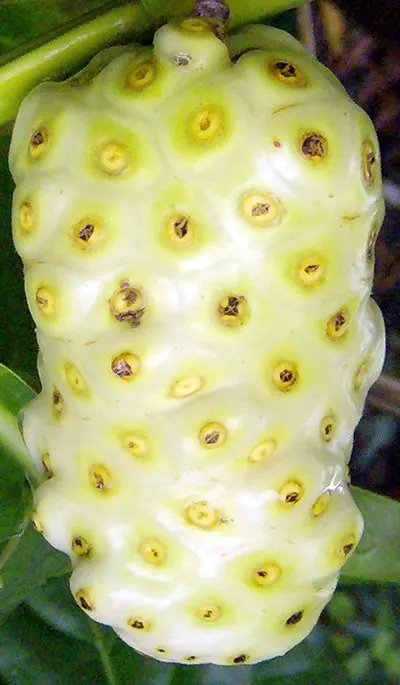
Noni fruit, also known as Morinda citrifolia, is a tropical fruit that is native to Southeast Asia and Australasia. The fruit is about the size of a potato and has a greenish-white exterior that is covered in small bumps.
Inside the fruit, there is a pungent, bitter pulp that has a distinct odor, often described as cheese-like or rancid. Despite its unpleasant taste and smell, noni fruit is believed to have a number of potential health benefits, particularly in traditional medicine.
Noni fruit is high in antioxidants, vitamins, and minerals, particularly vitamin C, potassium, and iron. It is believed to have anti-inflammatory, antibacterial, and analgesic properties and is commonly used in traditional medicine to treat a variety of ailments, including digestive issues, skin conditions, and pain.
#36 Physalis
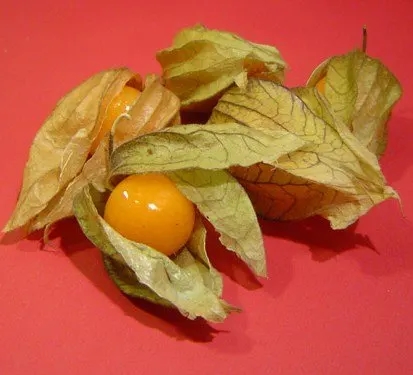
Physalis is a fruit that is also known as cape gooseberry, goldenberry, or ground cherry. It is native to South America but is now grown in many parts of the world, particularly in South Africa and Australia.
The fruit is about the size of a cherry tomato and is encased in a papery, lantern-like husk. The fruit itself is yellow-orange and has a tart, slightly sweet taste that is often compared to a mix of tomato and pineapple. The texture is similar to that of a cherry tomato, but with small edible seeds inside.
Physalis is high in vitamin C and other antioxidants and is believed to have a number of potential health benefits, including supporting healthy digestion, reducing inflammation, and boosting the immune system.
Physalis can be eaten raw, cooked, or used in various sweet or savory dishes, including salads, jams, pies, and sauces. The husks of the fruit can also be used for decorative purposes or added to tea for a subtle herbal flavor.
#37 Akebi Fruit
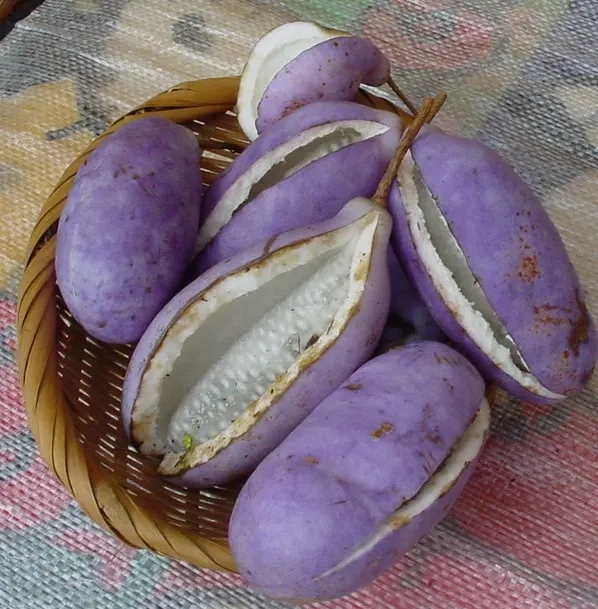
Akebi fruit, also known as chocolate vine or Akebia quinata, is a type of fruit that is native to Japan and China. The fruit is about the size of a small kiwi and has a thin, edible purple or white skin.
Inside the fruit, there is a white, gelatinous flesh that has a sweet, slightly tart taste and a texture that is similar to that of a grape. The seeds inside the fruit are also edible and have a nutty flavor.
Akebi fruit is high in antioxidants and is believed to have a number of potential health benefits, including supporting healthy digestion, reducing inflammation, and promoting healthy skin.
Akebi fruit can be eaten raw or used in various sweet or savory dishes, including desserts, jams, and salads. The fruit is also used in traditional medicine to treat a variety of ailments, including coughs, fever, and headaches.
#38 Cashew Fruit
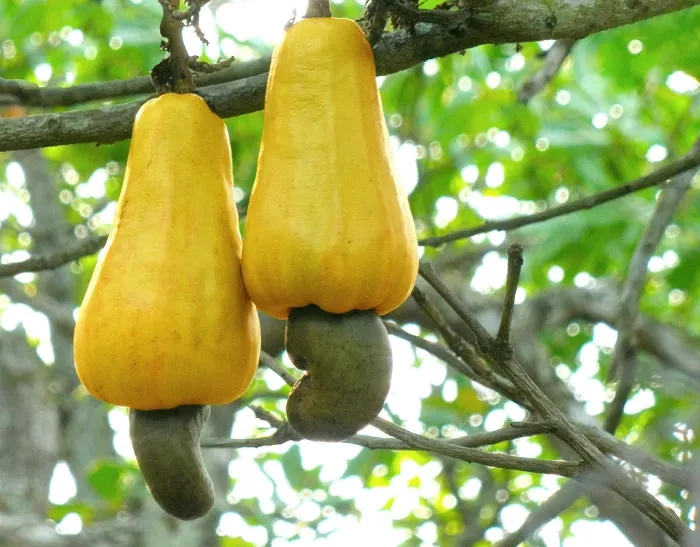
Cashew fruit is a tropical fruit that is native to Brazil but is now grown in many parts of the world, particularly in South America, Africa, and India. The fruit is often called the "cashew apple" because of its apple-like appearance, but it is not actually an apple.
The fruit is about the size of a small pear and has a yellow or red exterior that is thin and fragile. Inside the fruit, there is a pulpy, juicy flesh that is slightly sweet and tangy, similar to the taste of a mango or a pineapple. The flesh surrounds a hard, kidney-shaped seed, which is the actual cashew nut.
Cashew fruit is high in vitamin C, antioxidants, and minerals, particularly potassium and magnesium. It is believed to have a number of potential health benefits, including supporting healthy digestion, boosting the immune system, and promoting healthy skin.
Cashew fruit can be eaten raw, cooked, or used in various sweet or savory dishes, including jams, juices, and cocktails. The juice of the fruit is also commonly used in alcoholic beverages, particularly in Brazil.
#39 Rambutan
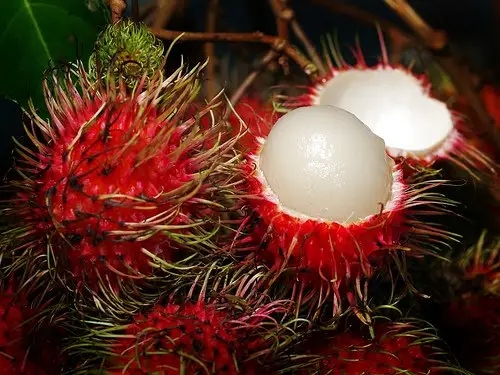
Rambutan is a tropical fruit that is native to Southeast Asia but is now grown in many parts of the world, including South America and Africa. The fruit is about the size of a golf ball and has a bright red or yellow exterior covered in soft, spiky hairs.
Inside the fruit, there is a white, juicy flesh that is similar in texture and taste to that of a grape. The flesh surrounds a hard, seed-like pit that is not edible. Rambutan has a sweet, slightly acidic taste that is often compared to that of a grape or a lychee.
Rambutan is high in vitamin C, antioxidants, and fiber, making it a healthy addition to any diet. It is believed to have a number of potential health benefits, including promoting healthy digestion, boosting the immune system, and reducing inflammation.
Rambutan can be eaten raw or used in various sweet or savory dishes, including salads, desserts, and cocktails. The fruit is also commonly canned or dried for preservation and export.
#40 Mangosteen
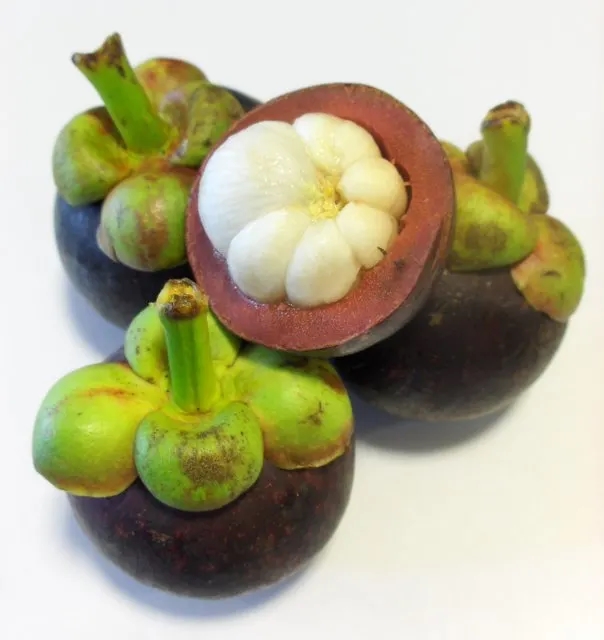
Indonesia, and Malaysia. The fruit is about the size of a tangerine and has a thick, dark purple or red exterior that is inedible.
Inside the fruit, there is a sweet, juicy white flesh that is divided into segments, similar to that of an orange. The flesh has a unique, delicate flavor that is often described as a combination of peach, strawberry, and pineapple, with a slightly sour note.
Mangosteen is high in antioxidants, particularly xanthones, and is believed to have a number of potential health benefits, including promoting healthy digestion, boosting the immune system, and reducing inflammation.
Mangosteen can be eaten raw or used in various sweet or savory dishes, including salads, desserts, and smoothies. The fruit is also commonly used in traditional medicine in Southeast Asia to treat a variety of ailments, including diarrhea, infections, and skin conditions.
#41 Durian
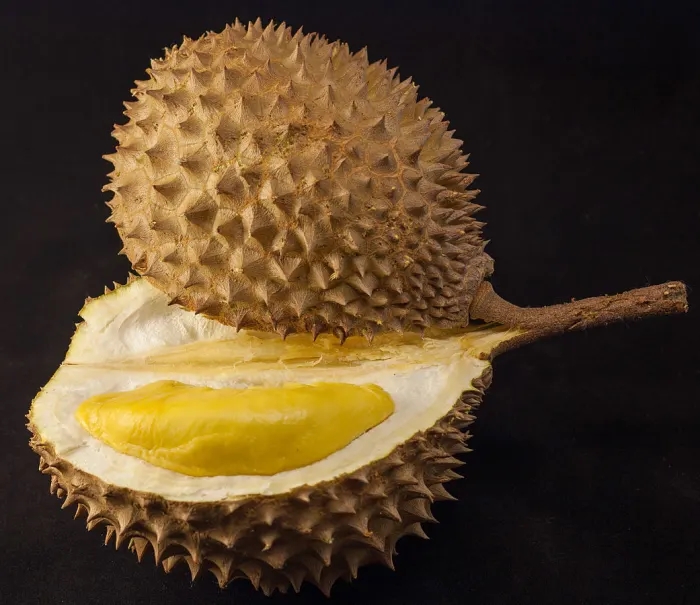
Durian is a tropical fruit that is native to Southeast Asia and is commonly found in Thailand, Malaysia, and Indonesia. The fruit is about the size of a large grapefruit and has a thick, spiky exterior that is green or brown in color.
Inside the fruit, there is a soft, creamy flesh that is yellow or white in color and has a distinct odor that some people find unpleasant. The taste of durian is sweet and rich, with a creamy, custard-like texture that is often compared to a mix of banana, pineapple, and vanilla.
Durian is high in fiber, vitamins, and minerals, particularly vitamin C, potassium, and iron. It is believed to have a number of potential health benefits, including promoting healthy digestion, reducing inflammation, and improving cardiovascular health.
Durian can be eaten raw or used in various sweet or savory dishes, including ice cream, desserts, and curries. The fruit is also commonly used in traditional medicine in Southeast Asia to treat a variety of ailments, including fever, diarrhea, and malaria.
#42 Romanesco Broccoli
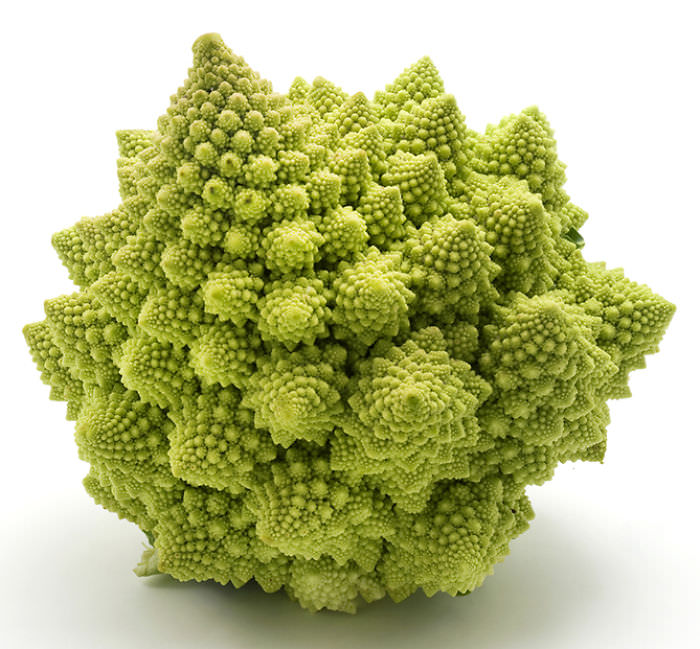
Romanesco broccoli, also known as Roman cauliflower, is a unique vegetable that belongs to the brassica family. It has a striking appearance, with a bright green head that is made up of a series of cone-shaped spirals that resemble a fractal pattern.
The taste of Romanesco broccoli is similar to cauliflower, but with a slightly nutty and earthy flavor. It can be cooked in a variety of ways, including steaming, roasting, and sautéing, and is a versatile ingredient in many dishes.
Originally from Italy, Romanesco broccoli is now grown in many parts of the world, including the United States, and is becoming increasingly popular due to its unique appearance and flavor. It is also considered to be a nutritious vegetable, high in vitamins C and K, fiber, and antioxidants, making it a healthy addition to any diet.



